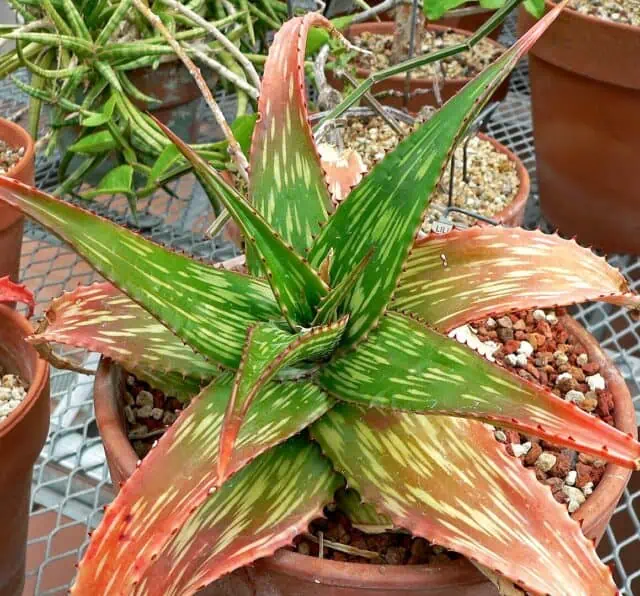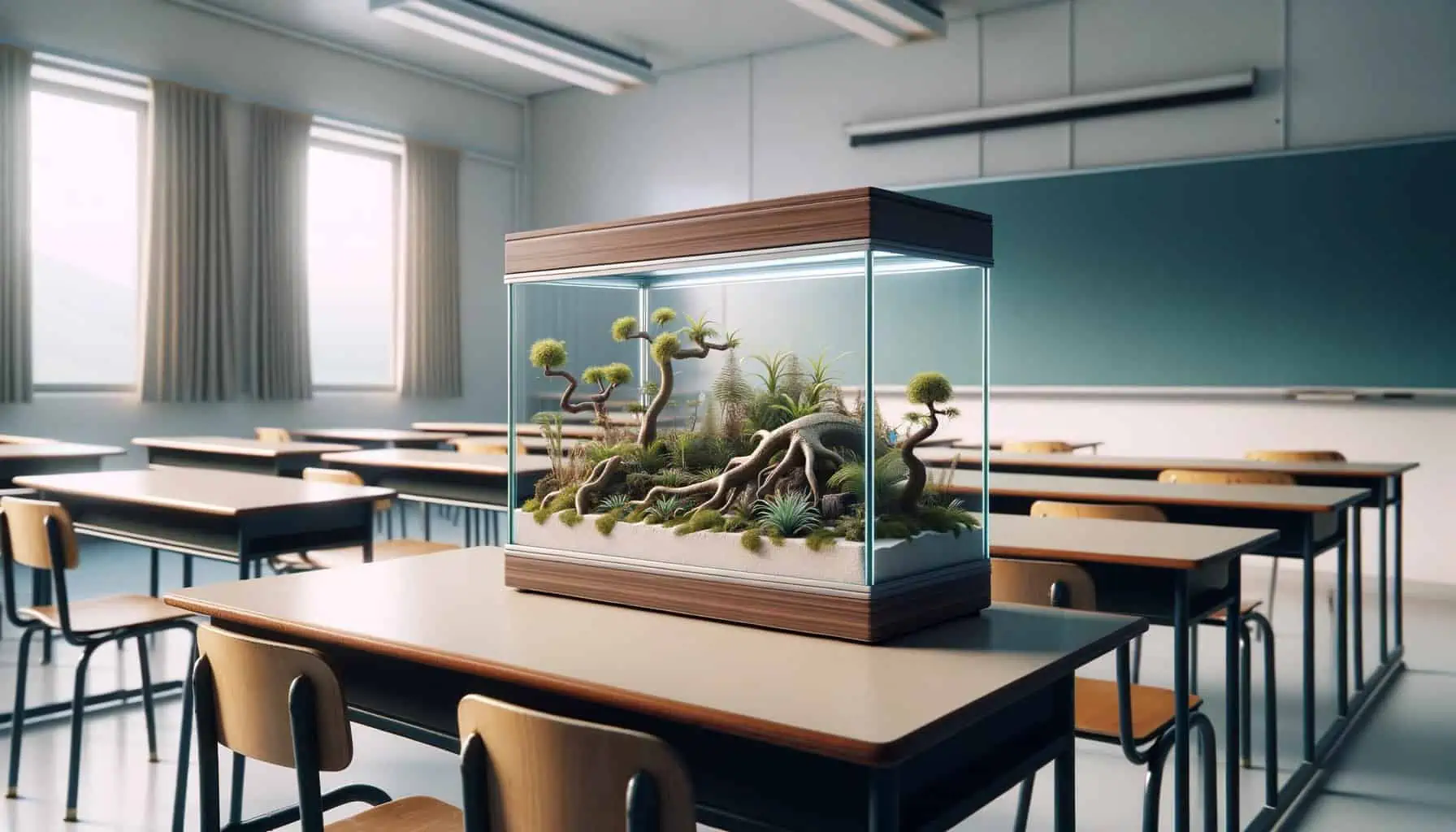Yes, aloe vera is safe to put in a leopard gecko tank. This succulent plant poses no harm to your reptile and even enhances the natural ambiance of the enclosure. Aloe vera varieties like Tiger Tooth Aloe and Sunset Aloe are both visually appealing and easy to care for.
They thrive in conditions similar to those preferred by leopard geckos, such as dry, well-drained soil and indirect sunlight. Therefore, incorporating aloe vera plants in a leopard gecko habitat is a beneficial choice for both the owner and the pet.
Choose Safe Aloe Varieties: Tiger Tooth Aloe and Sunset Aloe are safe and visually appealing options for a leopard gecko’s habitat.
Monitor Plant Health: Signs of an unhealthy plant include mushy, black, or shriveled leaves. A healthy aloe plant has firm, green leaves.
Leopard Geckos Usually Don’t Eat Aloe: They are primarily insectivores. If they do nibble, it’s generally not a concern but monitor for any unusual behavior.
Live Plants Offer Benefits: They improve air quality, act as humidity regulators, and provide hiding spots in the enclosure.
Check for Signs of Overwatering and Rot: Overwatered plants will have translucent leaves. Ensure the soil is well-drained to avoid root rot.
Types of Aloe Vera Plants That Are Safe For Leopard Geckos
Choosing the right type of aloe vera for your leopard gecko tank is crucial. Various aloe species are not only safe but also beneficial for creating a naturalistic enclosure.
Tiger Tooth Aloe (Aloe juvenna)
Tiger Tooth Aloe, or Aloe juvenna, is a unique choice for leopard gecko enclosures. This plant is known for its compact growth and fleshy leaves, which sport distinctive white stripes. Its size and structure make it an easy fit in a leopard gecko tank, taking up minimal space while adding visual appeal.
One of the advantages of using Tiger Tooth Aloe is its adaptability. It thrives in well-drained soil and prefers indirect light, conditions commonly found in leopard gecko habitats. Therefore, you don’t have to go out of your way to provide special care for this plant.
Sunset Aloe (Aloe dorotheae)
Sunset Aloe, scientifically known as Aloe dorotheae, is another excellent choice for your leopard gecko tank. What sets this plant apart is its colorful appearance. Its light green leaves are adorned with striking pink spikes along the edges, adding a pop of color to the enclosure.
When it comes to care, Sunset Aloe is relatively low-maintenance. It thrives in dry environments, which aligns perfectly with the habitat conditions of a leopard gecko tank. You won’t need to make special adjustments to accommodate this plant.
Short-leaved Aloe (Aloe brevifolia)
Short-leaved Aloe, or Aloe brevifolia, is characterized by its compact growth habit and notably short leaves. This makes it an ideal choice for a leopard gecko enclosure where space might be limited.
One of the standout traits of Aloe brevifolia is its adaptability. It’s a low maintenance plant, which is a bonus for those who want a hassle-free addition to their enclosure. Like other types mentioned, this aloe also thrives in dry environments, mirroring the natural habitat of a leopard gecko.
There are several advantages to incorporating Short-leaved Aloe into a leopard gecko habitat. It not only survives well in dry settings but also adds a layer of natural beauty. The plant enhances the tank’s visual appeal while remaining an easy-to-care-for choice.
Golden Tooth Aloe (Aloe nobilis)

Golden Tooth Aloe, also known as Aloe nobilis, is another plant that fits well in leopard gecko tanks. This particular aloe is notable for its golden yellow flowers and fleshy leaves with white stripes. Its aesthetic appeal and safe nature make it a good match for a leopard gecko’s living space.
When it comes to care requirements, Golden Tooth Aloe is fairly straightforward. It prefers well-drained soil and thrives in indirect light. As for watering, a moderate amount will suffice, avoiding overwatering to mimic the dry conditions suitable for a leopard gecko.
Lace Aloe (Aloe aristata)
Lace Aloe, or Aloe aristata, is another suitable plant choice for leopard gecko habitats. Known for its small size and succulent-like growth, this aloe variant is both attractive and practical. Its compact size makes it ideal for smaller enclosures, and its visual elements add a natural touch to the tank.
One of the best features of Lace Aloe is its adaptability. It can thrive in a variety of settings, from direct sun and warmth to partial shade, and it’s not very demanding in terms of water or soil quality.
Somalian Aloe (Aloe somaliensis)
The Somalian Aloe, or Aloe somaliensis, is another apt choice for leopard gecko tanks. Known for its unique features and growth habits, this succulent easily complements the natural habitat of these reptiles. Its compact size makes it ideal for tanks where space is limited, and it adds an aesthetic element as well.
What sets this aloe apart is its ability to thrive in dry environments. It doesn’t require much water, making it low maintenance and well-suited for a leopard gecko’s natural habitat. As for care, the Somalian Aloe prefers indirect light and temperatures that are neither too hot nor too cold.
Advantages of Having Live Plants in Your Leopard Gecko Enclosure
Including live plants in a leopard gecko enclosure offers several benefits. One notable advantage is the improvement of air quality. Plants absorb toxins and release oxygen, creating a healthier environment for your pet. Live plants also act as humidity regulators, helping to maintain a stable moisture level in the tank.
Furthermore, these plants can serve as hiding places for your gecko. Leopard geckos are naturally reclusive and appreciate spaces where they can escape and feel secure. The added foliage and structure offer them this sanctuary.
Ensure That It’s a Healthy Plant: Signs To Watch Out For
When adding aloe vera plants to a leopard gecko enclosure, it’s crucial to make sure they are healthy plants. One sign to be cautious of is overwatering. Overwatered aloe vera plants may have translucent leaves that feel mushy when touched. Another issue to look for is rot, which often manifests as black or shriveled leaves.
Specific visual cues can be helpful in identifying plant health. Translucent, black, shriveled, and mushy leaves are all indications of potential issues. These can signify sickness in the plant and can lead to fungal infections, which are harmful to both the plant and your leopard gecko.
Will Leopard Geckos Eat Aloe Plants?
When it comes to leopard geckos and aloe plants, the question often arises: Will they eat them? Generally, the answer is no. Leopard geckos are insectivores. This means their primary diet consists of live insects like crickets, mealworms, and roaches. However, some might occasionally nibble on plants in their terrariums.
Even if they do taste the aloe, it’s usually not a cause for major concern. That said, it’s essential to understand the potential risks involved. Aloe vera is not toxic to leopard geckos, but it’s not part of their natural diet either. As such, it’s crucial to provide a varied diet that primarily includes insects and is supplemented with calcium for optimal health.










